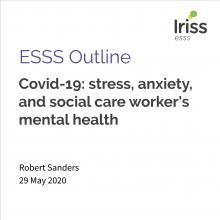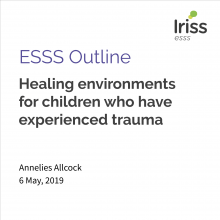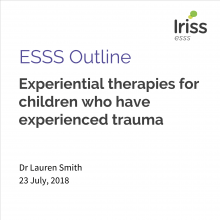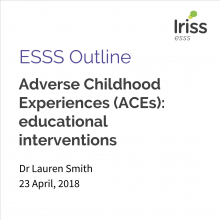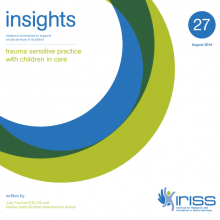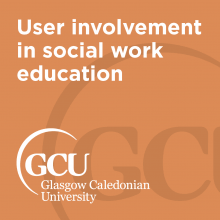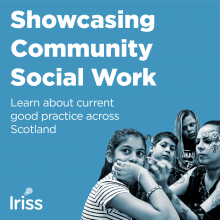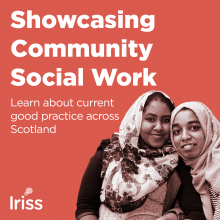Key points
- Unaccompanied asylum-seeking children and young people should have the same care planning processes in place as any other looked after and accommodated child, with a particular focus on education, employability and trauma recovery.
- There are tensions between immigration legislation and child welfare legislation. Immigration status is a determining factor in services which young people can access and their right to work and study.
- Social workers require an understanding of these tensions and must take them into account within the care planning process.
- Local authorities, within children’s services strategic plans, should recognise these tensions and consider policies and procedures which ensure that unaccompanied young people have the same opportunities as any other care experienced young person.
- There is a role for Scottish Government in developing policy and good practice guidelines to address tensions between immigration legislation and policy, and child welfare legislation and policy.
Introduction
Over the last 20 years, the numbers of unaccompanied children and young people travelling alone to Europe has increased sharply (UNICEF, 2018). There is no universal terminology to describe a child or young person who is seeking asylum alone. However, the legal definition as set out by the United Nations High Commissioner for Refugees (UNHCR) uses the term ‘unaccompanied’ and states that an unaccompanied child is ‘a person who is under the age of eighteen, unless, under the law applicable to the child, majority is attained earlier and who is separated from both parents and is not being cared for by an adult who by law or custom has responsibility to do so’ (UNHCR, 1997). In this Insight, the term ‘young person’ rather than ‘child’ will be used to more accurately reflect that the majority of young people who arrive alone in Scotland are between 14 and 17, and that local authorities have ongoing responsibilities to young people until the age of 26.
A growing body of literature explores the experiences of these young people both during their journeys to the UK and on arrival. While much of this research points to remarkable resilience, many young people have emotional health needs resulting from trauma prior to and during their journeys (Digidiki and Bhabha, 2017). They are also likely to have additional educational needs due to language barriers and interrupted (or no) formal education in their home countries (Hopkins and Hill, 2006). Young people’s experience of the immigration system can compound existing trauma, as they have to recount harrowing experiences in great detail, and often have to wait for some time before a decision is made on their claim for asylum (Crawley, 2007; Gentleman, 2018).
When children and young people arrive alone in the UK and become known to statutory agencies, they are ‘looked after’ by local authority social services departments who take on the role of ‘corporate parent’1. Local authority social workers take responsibility for ensuring access to services such as appropriate accommodation, health and education. However, as well as this supportive role, social workers in the UK also have a role in assessing the age of a young person where there is doubt that they are under 182 (Scottish Government, 2018a). This dual role – on the one hand offering support, on the other, denying support based on estimated age – is controversial. The British Association of Social Work (BASW) has suggested that age assessment is inconsistent with the stated commitment to human rights and social justice contained in the international definition of social work (BASW, 2015).
Although unaccompanied young people are legally ‘looked after’ children, they are also subject to immigration legislation. This is important to understand, as a young person’s immigration status, particularly post 18, can significantly impact on their ability to plan for their future (Chase and Allsop, 2013).
Social work with unaccompanied young people does not happen in a vacuum. In this summary, the focus is less on direct social work practice and more on the structural context of this work – the so-called ‘hostile environment’ (Grierson, 2018). An understanding of, and engagement with, this wider context is essential if social workers are to practise in a manner which recognises the complexities of young people’s lives. Social workers and local authorities need to understand the impact of immigration control on young people they are looking after, and ensure this is acknowledged and addressed at both practice and strategic levels.
Immigration in the UK – creating a hostile environment
The ‘hostile environment policy’ has been described as a flagship policy for Theresa May’s government (Grierson, 2018). The policy was intended to reduce ‘pull’ factors to the UK and encourage people to leave if their asylum application was unsuccessful (Bolt, 2016). It was underpinned by 2014 and 2016 Immigration Acts, which it has been suggested, have made immigration control part of daily life; public services (including social work), are increasingly expected to perform immigration functions (Yuval-Davis and colleagues, 2017; Farmer, 2017).
Although unaccompanied young people may initially be protected from the ‘hostile environment’ due to their status as children, the decision-making process can be lengthy, leading to uncertainty and anxiety. If their asylum claim is denied, a child in need of care and protection becomes, in the eyes of the Home Office, a refused asylum seeker in need of control. In Scotland, local authorities retain responsibility for young people as care leavers irrespective of their immigration status, however, care planning can be challenging as young people without leave to remain are unable to work and have limited options in relation to studying. They are also unable to claim any state benefits, open bank accounts or access social housing, and are potentially at risk of detention and removal (Chase and Allsop, 2013; McLaughlin, 2017; Chase and Segona, 2017). This applies to young people who have a live asylum application, as well as those whose application has been refused. These young people are living life in protracted limbo, unable to plan for their future which can lead to a fragile sense of belonging. There is, therefore, an inevitable tension between the objectives of the Home Office in relation to immigration control, and the ongoing pathway planning responsibilities of local authorities to young people for whom they are legally responsible.3
Reserved versus devolved power
Since 1999, Scotland has its own Parliament legislating on domestic Scottish matters, while foreign policy matters and immigration functions remain with Westminster. This may appear straightforward, however, Scotland believes it has its own unique needs in relation to migration which are not currently considered in immigration legislation and policy (Scottish Government, 2018b). Scotland also has a different approach in relation to asylum policy, with a focus on integration from arrival (Scottish Government and colleagues, 2018c).
The introduction of the 2014 and 2016 Immigration Acts have increased tensions between the Scottish Government, civil society in Scotland and the Westminster Government. It is suggested that these new Acts have encroached upon health, housing and social policies which are devolved to Scotland (Scottish Refugee Council, 2015). These tensions can be clearly seen in the roll-out of the Care Leavers Bursary, a flagship policy of the Scottish Government aiming to raise educational attainment for care experienced young people. At the moment, the bursary is not available to asylum-seeking young people until they have leave to remain (Scottish Funding Council, 2018). Arguably, as education is a devolved matter, this is potentially a decision for the Scottish Government rather than Westminster.
Unaccompanied young people in Scotland
In 2018, 140 unaccompanied children and young people were accommodated across Scotland, with a further 125 care leavers over the age of 18 (Rigby and colleagues, 2018). Most unaccompanied young people in Scotland are boys aged 16 and 17. The largest population of unaccompanied young people is in Glasgow, followed by Edinburgh, with very small numbers accommodated by other local authorities.
Many young people are victims of trafficking, with 46 referrals to the National Referral Mechanism4 in the final quarter of 2019 (Home Office, 2019). This is a significant increase from the final quarter of 2018 when only 14 children were identified (National Crime Agency, 2018). The highest number of referrals are for Vietnamese young people, much higher proportionally than in the rest of the UK.
Trafficking is a child protection issue: young people who are victims of trafficking have specific support needs which should be considered under local child protection procedures (Glasgow Child Protection Committee, 2019).
Legislative and policy framework
a) Convention on the rights of the child
The UN Convention on the Rights of the Child 1989 (CRC) is the main instrument used to consider the legal rights of all children and young people who are seeking asylum. Article 22 specifically sets out the responsibilities of state parties towards asylum-seeking children, however, all the articles of the CRC apply to every child within the state territory, and not only citizen children (Committee of the Rights of the Child, 2005). State parties, however, can apply reservations which limit the impact of the Convention (Bhabha, 2008).
The UK ratified the CRC in 1991, and the government's position is that all legislation and policy is convention compliant. However, it has been suggested that UK immigration policy and legislation has a significant impact on children's rights, with children and their families left destitute when they have ‘no recourse to public funds’ (Farmer, 2017). The age assessment process has also been said to be in breach of children’s rights, given the grave implications of children being treated as adults within the asylum process (Finch, 2014).
b) Scottish child welfare legislation
Under S25 of the Children (Scotland) Act 1995 (the Act), any child arriving in Scotland on their own will be accommodated by the local authority. Until relatively recently, local authorities often provided accommodation under S22 of the Act for young people aged 16 and 17 (Legal Services Agency (LSA), 2013). This interpretation of the legislation meant that at age 18 there was no responsibility on the local authority to provide throughcare and aftercare support. LSA argued this was unlawful; following this intervention, it is now generally accepted that anyone under 18 who presents to the local authority and is provided with accommodation and support, is a looked-after young person under S25 of the Act. Therefore, they are entitled to access leaving-care support under S29. Under new provisions contained in the Children and Young People Act (2014), this support can continue until age 26 if required.
c) Policy framework
The policy framework underpinning all work with children and young people in Scotland is Getting it Right for Every Child (GIRFEC) (Scottish Executive, 2006). GIRFEC stresses a holistic multi-agency approach which should inform all assessments and plans for children and young people in need. Given the CRC's requirements regarding refugee children (Article 22), and the elaboration of States’ responsibilities towards unaccompanied children contained within General Comment No 6, it is clear that all unaccompanied children and young people should have access to the same assessment and planning framework, including leaving care planning, as any other looked-after child.
The Scottish Government has taken a particular interest in the needs of care experienced young people with the root and branch review of care5 and a number of measures have been announced to improve young people’s care and aftercare experience. However, as noted above, unaccompanied young people’s immigration status may prevent them from benefiting from these measures. As noted by Rigby and colleagues (2018), this group of young people is not mentioned in leaving care policy or legislation and they are almost absent from the New Scots Refugee Strategy (Scottish Government and colleagues, 2018c). Similarly, the needs of unaccompanied young people are absent from the Care Leavers Covenant (Barnardos and colleagues, 2015).
As part of the care review, a roundtable discussion was convened in May 2019 to consider the particular needs of unaccompanied young people and First Minister Nicola Sturgeon has personally met with a group of young people supported by the Scottish Guardianship Service (Goodwin, 2019). These are positive developments and indicate that the complex needs of unaccompanied young people will likely be recognised.
Child first, migrant second?
Policy, legal briefings, academic literature and good practice guidelines on unaccompanied young people stress a ‘child first, migrant second’ approach (Crawley, 2006; SCEP, 2009). This approach recognises the legal complexities but fundamentally believes that children’s needs are best met by seeing them as ‘children first and migrants second’ (Crawley, 2006) and ensuring that their rights under international law are upheld.
However, McLaughlin (2018) is highly critical of this, believing that this approach doesn’t recognise the complexity of unaccompanied young people’s lives. For McLaughlin, ‘the non-citizen child is always subject to the border first, a political reality which unsettles the ethical foundations of the ‘child first, migrant second’ approach’ (McLaughlin, 2018, pp1761-1762).
For young people without leave to remain there is undeniably a tension between child welfare and immigration policies and legislation (Crawley, 2006; Chase and Allsop, 2013; Bhabha, 2009). This tension is often said to problematise the role of social workers: on the one hand they are ‘corporate parents’ for these young people; on the other, they may be effectively undertaking immigration functions, for example, age assessments or working on life plans for young people which focus on return to their country of origin (Chase and Allsop, 2013; Silverman, 2016).
This tension between welfare and immigration control is particularly apparent during the transition to adulthood. Although local authorities should consider the best interests of young people until age 26, immigration legislation is clear that young people are only protected from the adult asylum system until they are legally adults. This has led to calls for immigration policy and legislation to be brought into line with child welfare legislation (SCEP, 2009).
Social work practice with unaccompanied children and young people
Kohli (2006) notes that much of the literature relating to social work with this group is very critical of social work practice. However, Kohli’s research found that while social workers may have varying motivations and focuses, the evidence suggests that they cared for young people well. Kohli found very little evidence of practitioners behaving as ‘border guards’; indeed, he concluded that the young people ‘appeared to receive an attuned service in relation to their needs’.
Conversely, in a more recent Swedish study offering an insight from young people themselves, Herz and Lalander (2018) concluded that ‘it is not possible to discern what is evident in Kohli’s research: helpful and therapeutic social workers who care and are good companions’ (Herz and Lalander, 2018, p9). Although there were some examples of good relationships between young people and social workers, a more ‘human’ and empathic approach by the social worker was the exception rather than the rule. Generally, young people found their social workers to be distant ‘bystanders with power’, appearing irregularly to offer bad news and then disappearing again. Herz and Lalander suggest that social workers simply did not have sufficient time to develop therapeutic relationships with young people and so were seen as part of an oppressive immigration system. This was also highlighted in a UK study by Chase (2009), who found that on the whole, young people did not have positive, trusting relationships with social workers.
For young people leaving care, pathway planning is the key task, however, this is problematic for unaccompanied young people with insecure immigration status given restrictions on work and study and an uncertain future in the UK (Devenney, 2017). The role of social work may be in assisting young people ‘in coming to terms with a story that may end (or indeed begin) with return’ (Devenney, 2017, p1320). However, discussing a return to country of origin as part of the pathway planning process risks alienating young people who find the idea of return deeply distressing (Chase and Allsop, 2013).
Lessons for policy and practice
Although it may be tempting to advocate for unaccompanied young people as ‘children first and migrants second’, the evidence suggests that in some areas these young people are very clearly migrants first. The immigration process to which they are exposed is far from child friendly, thus, while social work services need to ensure that they are subject to the same processes as any other looked after young people, the reality is that they often cannot access the same services until they have leave to remain. Although the majority of young people are eventually granted some form of leave to remain, the legal process can take months and even years. Social workers and local authorities need to recognise and plan with this reality in mind, and a key task is ensuring that young people have access to legal advice and independent advocacy. In their role as corporate parents, local authorities need to be aware that immigration status may affect young people’s access to services, and take steps to mitigate this where necessary.
Pathway planning is a key social work task for all care leavers. For young people with insecure immigration status this is a complex task which must be approached with sensitivity and skill, and a focus on what is possible rather than what isn’t. Even for young people who do have leave to remain, pathway planning is not straightforward; there are likely to be barriers resulting from experience of trauma, interrupted education and English language acquisition. Like any other care experienced young people, unaccompanied young people need targeted education and employability support to ensure they can achieve to the best of their ability.
The Scottish Government has stated its intention for Scotland to be ‘the best place in the world for children to grow up’ (Scottish Government, 2017). For this to be achieved, the needs of unaccompanied young people must be recognised at a structural level and services developed which support them in their complex, and at times, uncertain journey to adulthood.
References
- Ang J (2014) Legal issues in the accommodation and support of asylum seeking and trafficked children under the Children (Scotland) Act 1995. Edinburgh: Legal Services Agency.
- Bhabha J (2009) Arendt’s children: do today’s migrant children have a right to have rights? Human Rights Quarterly, 31, 2, 410-451
- Bolt D (2016) An inspection of the 'hostile environment' measures relating to driving licenses and bank accounts: January to July 2016. London: Independent Chief Inspector of Borders and Immigration.
- British Association of Social Workers (2015) BASW response to the age assessment guidance document.
- Chase E (2009) Agency and silence: young people seeking asylum alone in the UK. British Journal of Social Work, 40, 7, 2050-2068
- Chase E and Allsop J (2013) Future citizens of the world: the contested futures of young migrants in Europe. RSC working paper series no 97. Barnett papers in social research. Oxford: Refugee Studies Centre.
- Chase E and Sigona N (2017) Forced returns and protected displacement. Research brief no 7.
- Committee on the Rights of the Child (2005) General comment no 6: treatment of unaccompanied and separated children outside their country of origin. Geneva: United Nations.
- Crawley H (2006) Child first, migrant second: ensuring that every child matters. ILPA policy paper. London: Immigration Law Practitioners Association.
- Crawley H (2007) When is a child not a child? Asylum, age disputes and the process of age assessment. London: Immigration Law Practitioners Association.
- Devenney K (2017) Pathway planning with unaccompanied young people leaving care: biographical narratives of past, present, and future. Child & Family Social Work, 22, 3, 1313-1321
- Digidiki V and Bhabha J (2017) Emergency within an emergency, the growing epidemic of sexual exploitation and abuse of migrant children in Greece. FXB Center for Health and Human Rights, Harvard University
- Farmer N (2017) 'No recourse to public funds', insecure immigration status and destitution: the role of social work? Critical and Radical Social Work, 5, 3, 357-367
- Finch N (2014) Always migrants, sometimes children. London: Coram Children’s Legal Centre.
- Gentleman A (2018) Suicide raises alarm about UK’s treatment of child refugees. The Guardian.
- Glasgow Child Protection Committee (2019) Child trafficking and exploitation inter agency guidance.
- Goodwin K (2019) Record numbers of young people use trafficking support service. The National.
- Grierson J (2018) Hostile environment: anatomy of a policy disaster. The Guardian.
- Herz M and Lalander P (2018) An abstract and nameless, but powerful, bystander – ‘unaccompanied children’ talking about their social workers in Sweden. Nordic Social Work Research, 9, 1, 18-28
- Home Office (2019) National referral mechanism statistics quarter 3 2019: July to September: data tables.
- Hopkins P and Hill M (2010) The needs and strengths of unaccompanied asylum-seeking children and young people in Scotland. Child & Family Social Work, 15, 4, 399-408
- Kohli R (2006) Social work with unaccompanied asylum seeking children. Basingstoke: Palgrave Macmillan
- McLaughlin C (2017) ‘They don’t look like children’: child asylum-seekers, the Dubs amendment and the politics of childhood. Journal of Ethnic and Migration Studies, 44,11, 1757-1773
- National Crime Agency (2018) NRM statistics.
- Rigby P, Fotopoulou M, Rogers A et al (2018) Responding to separated and unaccompanied minors in Scotland: policy and local authority perspectives. Stirling: University of Stirling.
- Scottish Care Leavers Covenant (2015)
- Scottish Executive (2006) Getting it right for every child: implementation plan.
- Scottish Funding Council (2018) Letter to college principals.
- Scottish Government (2017) National outcomes, children young people and families.
- Scottish Government (2018a) Age assessment practice guidance for Scotland.
- Scottish Government (2018b) Scotland’s population needs and migration policy. Discussion paper for evidence, policy and powers for the Scottish Parliament.
- Scottish Government (2018c) New Scots: refugee integration strategy 2018 to 2022.
- Scottish Refugee Council (2015). ILPA briefing for second reading of the Immigration Bill in House of Commons on 13 October 2015
- Separated Children in Europe Programme (2009) Statement of good practice.
- Silverman S (2016) 'Imposter-children' in the UK refugee status determination process. Refuge, 32, 3, 30-39
- UNHCR (1997) Guidelines on policies and procedures in dealing with unaccompanied children seeking asylum. Geneva: UNHCR.
- UNICEF (2018) Children on the move. Key facts and figures.
- United Nations (1989) Convention on the Rights of the Child. New York
- Yuval-Davis N, Wemyss G and Cassidy K (2017) Everyday bordering, belonging and the reorientation of British immigration legislation. Sociology, 52, 2, 228-244
Acknowledgements
This Insight was reviewed by Helen Allbutt (NHS Education for Scotland), Natalia Farmer (Glasgow Caledonian University), Paul Rigby (University of Stirling), Jane Stewart and Ruth Weston (City of Edinburgh Council), Colin Turbett (social work author) and colleagues from Scottish Government. We would also like to thank Just Right Scotland for their contribution. Comments represent the views of reviewers and do not necessarily represent those of their organisations. Iriss would like to thank the reviewers for taking the time to reflect and comment on this publication.
1 For a summary of legislation in relation to corporate parenting responsibilities for local authorities and other organisations in Scotland see https://www.corporateparenting.org.uk
2 Age assessments are carried out where there is a dispute over whether the young person is under 18. In the UK, unlike any other country in Europe, this function lies solely with local authority social workers.
3 The Immigration Act 2016 has sought to remove the duty of local authorities to support these young people if they are over 18 and are deemed to be ‘appeals rights exhausted’. This legislation does not apply in Scotland, but it is possible that it could be introduced.
4 The National Referral Mechanism (NRM) ‘is a framework for identifying victims of human trafficking or modern slavery and ensuring they receive the appropriate support’. (National Crime Agency, 2018).
5 The Independent Care Review: https://www.carereview.scot
